Journal list menu
Export Citations
Download PDFs
Editor's Choice
EDITORIALS
Public health promotion: the role of the dermatologist
- Pages: 1-2
- First Published: 14 July 2015
Guidelines for statistical reporting in the British Journal of Dermatology
- Pages: 3-5
- First Published: 14 July 2015
COMMENTARIES
Reflectance confocal microscopy for better management of cutaneous pink lesions
- Pages: 6-7
- First Published: 14 July 2015
Associations between Merkel cell carcinoma and Merkel cell polyomavirus
- Pages: 7-8
- First Published: 14 July 2015
Reflectance confocal microscopy: a new key for assessing the role of Demodex in rosacea?
- Pages: 8-9
- First Published: 14 July 2015
BRAF in early stage melanoma: rationale for testing and treatment?
- Pages: 9-10
- First Published: 14 July 2015
Qualitative accounts of living with cutaneous T-cell lymphoma
- Pages: 10-11
- First Published: 14 July 2015
Methylisothiazolinone in rinse-off products: additional fuel to the world epidemics of allergic contact dermatitis to isothiazolinones
- Page: 11
- First Published: 14 July 2015
Increased risk of psoriasis in individuals with childhood asthma: therapeutic implications?
- Page: 14
- First Published: 14 July 2015
Ablative fractional laser assisted photodynamic therapy for the treatment of actinic cheilitis
- Page: 15
- First Published: 14 July 2015
Interventions for the pain of topical photodynamic therapy
- Pages: 15-16
- First Published: 14 July 2015
Doxycycline in the treatment of bullous pemphigoid: as good as systemic corticosteroids?
- Pages: 17-18
- First Published: 14 July 2015
REVIEW ARTICLES
Phototherapy, photodynamic therapy and photophoresis in the treatment of connective-tissue diseases: a review
- Pages: 19-30
- First Published: 15 November 2014
What's already known about this topic?
- Connective-tissue diseases, including lupus erythematosus, morphoea/scleroderma and dermatomyositis, occur in patients who are medically complex and have unique cutaneous manifestations that may be recalcitrant to conventional therapies.
- Given the association of connective-tissue diseases and photosensitivity, the use of light-based therapeutic modalities for these conditions is controversial.
What does this study add?
- This review is the first report to examine the evidence available in the literature for the treatment of lupus, morphoea, scleroderma and dermatomyositis with phototherapy, photodynamic therapy and photopheresis.
- Cutaneous manifestations of some of these connective-tissue disorders may be effectively and safely treated with light-based modalities despite associations with photosensitivity.
Reflectance confocal microscopy in the diagnosis of solitary pink skin tumours: review of diagnostic clues
- Pages: 31-41
- First Published: 30 January 2015
What's already known about this topic?
- Solitary pink tumours represent a diagnostic challenge for clinicians as they often reveal subtle clinical and dermoscopic features.
- Reflectance confocal microscopy (RCM) has been shown to improve the accuracy of diagnosis of amelanotic melanoma and basal cell carcinoma.
What does this study add?
- This review describes the criteria for RCM diagnosis of neoplasms that present as solitary pink lesions.
- This descriptive information may facilitate the formulation of prospective studies testing RCM-based diagnosis of amelanotic neoplasms.
SYSTEMATIC REVIEW
Merkel cell carcinoma and Merkel cell polyomavirus: a systematic review and meta-analysis
- Pages: 42-49
- First Published: 27 April 2015
What's already known about this topic?
- Several studies have assessed the correlation between Merkel cell carcinoma and Merkel cell polyomavirus with inconsistent results.
What does study add?
- A systematic review and a meta-analysis including all studies from January 2008 to August 2014.
- The findings support the association between Merkel cell carcinoma and Merkel cell polyomavirus.
Original Articles
CLINICAL AND LABORATORY INVESTIGATIONS
Histopathology of drug rash with eosinophilia and systemic symptoms syndrome: a morphological and phenotypical study
- Pages: 50-58
- First Published: 29 January 2015
What's already known about this topic?
- The histological features of drug rash with eosinophilia and systemic symptoms (DRESS) vary from spongiotic dermatitis to an erythema multiforme-like aspect.
- In DRESS, skin biopsies often show eosinophils and apoptotic bodies.
- Atypical lymphocytes may be found in skin infiltrates.
What does this study add?
- The association of several inflammatory patterns in a single biopsy is suggestive for diagnosis.
- Cutaneous infiltrates can compromise atypical lymphocytes resembling Sézary cells.
- DRESS shows a higher density of inflammatory infiltrates, more apoptosis, associated inflammatory patterns and granzyme B+ cells than maculapapular rash.
- Effector T cells are mainly polyclonal granzyme B+ CD8+ T cells.
Anti-desmocollin autoantibodies in nonclassical pemphigus
- Pages: 59-68
- First Published: 01 February 2015
What's already known about this topic?
- Despite the established pathogenic role of anti-desmoglein (Dsg) antibodies in classical pemphigus, the significance of autoantibodies to another desmosomal cadherin, desmocollin (Dsc), is at present unknown.
- No consistent immunoassay for IgG autoantibodies to Dscs has been developed.
What does this study add?
- We have successfully established new sensitive and specific mammalian Dsc immunoglobulin (Ig) G enzyme-linked immunosorbent assays.
- Our data show that IgG anti-Dsc autoantibodies are frequently detected and potentially pathogenic in particular types of nonclassical pemphigus.
Reflectance confocal microscopy for monitoring the density of Demodex mites in patients with rosacea before and after treatment
- Pages: 69-75
- First Published: 20 March 2015
What's already known about this topic?
- Demodex mites probably play an important role in the pathogenesis of Demodex-associated skin diseases such as rosacea.
- Reflectance confocal microscopy (RCM) allows the detection and quantification of Demodex mites in vivo.
- In patients with rosacea significantly higher numbers of Demodex folliculorum have been detected compared with healthy controls.
What does this study add?
- In patients with rosacea the density of Demodex mites can be monitored noninvasively during therapy using RCM.
- Repeated examination of the same site showed that the absolute numbers of mites, as well as the number of mites per follicle, significantly decreased.
The role of BRAF mutations in primary melanoma growth rate and survival
- Pages: 76-82
- First Published: 05 March 2015
What's already known about this topic?
- There is some evidence that BRAF mutations are associated with poor prognosis in primary melanoma, although most studies focus on patients with metastatic melanoma.
What does this study add?
- Evidence for clinical and behavioural differences between BRAFV600E and BRAFV600K molecular subtypes.
- BRAF mutations are associated with poorer melanoma-specific survival in patients with stage I–III melanoma.
- Mutation status should be considered as a prognostic factor in this group, particularly with adjuvant therapies on the horizon.
‘We had to change to single beds because I itch in the night’: a qualitative study of the experiences, attitudes and approaches to coping of patients with cutaneous T-cell lymphoma
- Pages: 83-92
- First Published: 16 February 2015
What's already known about this topic?
- Quantitative assessment tools indicate that quality of life for people living with cutaneous T-cell lymphoma (CTCL) can be poor.
What does this study add?
- Greater depth of understanding of the extent of the challenges of living with CTCL but also of what is supportive.
Histopathological and immunophenotypical criteria for the diagnosis of Sézary syndrome in differentiation from other erythrodermic skin diseases: a European Organisation for Research and Treatment of Cancer (EORTC) Cutaneous Lymphoma Task Force Study of 97 cases
- Pages: 93-105
- First Published: 09 April 2015
What's already known about this topic?
- Several small, single-centre studies have reported histopathological criteria for Sézary syndrome (SS) that allow differentiation from erythrodermic inflammatory dermatoses (EIDs).
- Most histopathological and immunohistochemical criteria have never been evaluated in a multicentre study.
What does this study add?
- Histology of SS skin biopsies revealed a significantly increased degree of epidermotropism and more intraepidermal atypical lymphocytes compared with EID, and Pautrier microabscesses were seen only in SS samples.
- The lymphocytic infiltrate in SS skin samples was found significantly to express PD-1, MUM-1 and Ki-67, and showed less infiltration of CD8+ lymphocytes.
Pigmented nodular melanoma: the predictive value of dermoscopic features using multivariate analysis
- Pages: 106-114
- First Published: 27 April 2015
What's already known about this topic?
- Nodular melanoma (NM) often exhibits features associated with deep tumour extension and less commonly displays the classic dermoscopic features of superficial spreading melanoma (SSM).
What does this study add?
- The study identifies dermoscopic features that are significantly associated with pigmented NM compared with pigmented SSM and nonmelanoma nodular lesions.
- This study validates, with a multivariate analysis, the dermoscopic features leading to a significantly increased likelihood of a diagnosis of pigmented NM.
CUTANEOUS ALLERGY
Methylisothiazolinone in rinse-off products causes allergic contact dermatitis: a repeated open-application study
- Pages: 115-122
- First Published: 24 February 2015
What's already known about this topic?
- The prevalence of contact allergy to methylisothiazolinone (MI) has increased dramatically during recent years.
What does this study add?
- In a repeated open application test, we showed that nearly all MI-allergic subjects developed allergic contact dermatitis from using cosmetic rinse-off products containing allowed concentrations of MI (100 ppm or 50 ppm).
- The elicitation threshold is certainly far below 50 ppm.
- The current levels of MI are not safe.
DERMATOLOGICAL SURGERY AND LASERS
Additional review of Mohs slides to optimize Mohs micrographic surgery
- Pages: 123-127
- First Published: 24 February 2015
What's already known about this topic?
- The success of Mohs surgery depends on correct interpretation of slides.
What does this study add?
- Pathologists detected incompletely excised basal cell carcinomas on 2% of Mohs slides.
- An additional review of Mohs slides might increase accurate interpretation and therefore prevent skin cancer recurrence.
DERMATOPATHOLOGY
Reflectance confocal microscopy correlates of dermoscopic patterns of facial lesions help to discriminate lentigo maligna from pigmented nonmelanocytic macules
- Pages: 128-133
- First Published: 21 November 2014
What's already known about this topic?
- The clinical diagnosis of facial pigmented lesions can be challenging because of the overlapping features of benign and malignant entities.
- Dermoscopy and reflectance confocal microscopy (RCM) can assist in the diagnostic process.
What does this study add?
- This article provides an original perspective regarding the role of dermoscopy and RCM in the diagnosis of facial malignant lesions.
- RCM can be used to assess appropriate treatment options and follow-up protocols for facial lesions.
Secondary cutaneous lymphoma: comparative clinical features and survival outcome analysis of 106 cases according to lymphoma cell lineage
- Pages: 134-145
- First Published: 31 December 2014
What's already known about this topic?
- Lymphoma is a diverse group of malignancies that includes many different categories.
What does this study add?
- The characteristics of skin lesions in secondary cutaneous lymphoma are different depending on the lymphoma cell lineages.
- Skin lesion characteristics such as time point of appearance and extent affect the survival of secondary cutaneous lymphoma.
EPIDEMIOLOGY AND HEALTH SERVICES RESEARCH
Increased risk of glomerulonephritis and chronic kidney disease in relation to the severity of psoriasis, concomitant medication, and comorbidity: a nationwide population-based cohort study
- Pages: 146-154
- First Published: 15 December 2014
What's already known about this topic?
- There is an increased risk of multiple comorbidities in patients with psoriasis.
What does this study add?
- Both mild and severe psoriasis presented an increased risk of chronic kidney disease (CKD) and glomerulonephritis, independent of traditional risk factors for CKD.
- The development of CKD in patients with psoriasis was multifaceted. High severity, psoriatic arthritis involvement and concomitant nonsteroidal anti-inflammatory drug use further increased the risk of CKD in patients with psoriasis.
Intellectual disability and cognitive ability in Darier disease: Swedish nation-wide study
- Pages: 155-158
- First Published: 21 February 2015
What's already known about this topic?
- Anecdotal evidence suggests a relationship between Darier disease and intellectual disability, but is limited by the absence of control populations.
What does this study add?
- This report confirms that Darier disease is associated with intellectual disability and subclinical impairments in cognitive ability, according to data from the Swedish nation-wide registers.
Risk of psoriasis in patients with childhood asthma: a Danish nationwide cohort study
- Pages: 159-164
- First Published: 20 March 2015
What's already known about this topic?
- Psoriasis may be associated with increased risk of asthma, but the inverse relationship has not been investigated.
What does this study add?
- Asthma in childhood is associated with a significantly increased risk of psoriasis.
The impact of national-level interventions to improve hygiene on the incidence of irritant contact dermatitis in healthcare workers: changes in incidence from 1996 to 2012 and interrupted times series analysis
- Pages: 165-171
- First Published: 05 February 2015
What's already known about this topic?
- Addressing healthcare-associated infections (HCAI) through improved hygiene has been a priority for the National Health Service since 2000.
- Irritant contact dermatitis (ICD) frequently occurs in healthcare workers (HCWs) as a result of hand hygiene measures or wet work.
What does this study add?
- ICD in U.K. HCWs attributed to hand and/or other hygiene has substantially increased since 1996, consistent with interventions to reduce HCAI including the Cleanyourhands campaign.
Statistical reporting in randomized controlled trials from the dermatology literature: a review of 44 dermatology journals
- Pages: 172-183
- First Published: 18 May 2015
What's already known about this topic?
- Previous studies have found varied levels of statistical reporting across different medical specialties.
What does this study add?
- The present study demonstrates a low level of statistical reporting in randomized controlled trials from the dermatology literature.
PHOTODERMATOLOGY
Efficacy of ablative fractional laser-assisted photodynamic therapy for the treatment of actinic cheilitis: 12-month follow-up results of a prospective, randomized, comparative trial
- Pages: 184-191
- First Published: 15 November 2014
What's already known about this topic?
- Photodynamic therapy (PDT) is less efficient for actinic cheilitis (AC) than for actinic keratosis.
- Use of an erbium:yttrium–aluminium–garnet ablative fractional laser (Er:YAG AFL) improves the methyl aminolaevulinate (MAL) penetration into deeper portions of lesions.
What does this study add?
- The present study showed Er:YAG AFL-assisted MAL-PDT is better for the treatment of AC and requires fewer sessions than conventional MAL-PDT.
PHOTOBIOLOGY
Comparing cold-air analgesia, systemically administered analgesia and scalp nerve blocks for pain management during photodynamic therapy for actinic keratosis of the scalp presenting as field cancerization: a randomized controlled trial
- Pages: 192-200
- First Published: 21 November 2014
What's already known about this topic?
- Pain is a common and significant side-effect of photodynamic therapy (PDT).
- Scalp nerve blocks are an effective pain reduction strategy during PDT in patients with field cancerization.
What does this study add?
- To the best of our knowledge, this is the first randomized controlled trial comparing scalp nerve blocks, intravenously administered analgesia in combination with cold-air analgesia and cold-air analgesia alone for managing pain during PDT.
- In contrast to scalp nerve blocks, intravenously administered analgesia and cold-air analgesia did not lead to a considerable reduction in pain.
Predicted increased risk of squamous cell carcinoma induction associated with sunbed exposure habits
- Pages: 201-208
- First Published: 03 February 2015
What's already known about this topic?
- Cumulative exposure to solar ultraviolet radiation (UVR) is a risk factor in the induction of squamous cell carcinoma (SCC).
- High-output sunbeds emit significant levels of UVB radiation.
- Sunbeds in the U.K. emit UVR levels that exceed the European limits.
What does this study add?
- This study uses published emission spectra from sunbeds to quantify the increased risk of SCC induction according to pattern of use and background sunlight exposure.
- By age 55 years, the risk of SCC induction from exposure to median UVR levels between the ages of 20 and 35 years from a sunbed is increased by 90%.
- A predictive, quantifiable relation is proposed between sunbed use, including the type of sunbed used, and SCC induction.
THERAPEUTICS
Evaluation of the efficacy of cysteamine 5% cream in the treatment of epidermal melasma: a randomized double-blind placebo-controlled trial
- Pages: 209-217
- First Published: 23 September 2014
What's already known about this topic?
- Melasma is an acquired hyperpigmentary disease that is hard to treat.
- Cysteamine is known to be a depigmenting agent, but has not been studied in the treatment of melasma.
What does this study add?
- Cysteamine showed greater efficacy than placebo in the treatment of melasma, at both 2 and 4 months.
- Cysteamine showed significant efficacy both by Investigator's Global Assessment and patients’ viewpoints.
4-Hexyl-1,3-phenylenediol, a nuclear factor-κB inhibitor, improves photodamaged skin and clinical signs of ageing in a double-blinded, randomized controlled trial
- Pages: 218-226
- First Published: 06 March 2015
What's already known about this topic?
- The nuclear factor-κB (NF-κB) pathway is a key mediator of inflammation and may be involved in skin ageing.
What does this study add?
- Cultured fibroblasts from donors ≥ 50 years old had higher levels of NF-κB activity than fibroblasts obtained from donors < 50 years old.
- In humans, treatment with an NF-κB inhibitor significantly improved clinical parameters in photodamaged skin.
- These findings support the hypothesis that NF-κB activation may accelerate the skin ageing process.
A randomized controlled trial to compare the safety and effectiveness of doxycycline (200 mg daily) with oral prednisolone (0·5 mg kg−1 daily) for initial treatment of bullous pemphigoid: a protocol for the Bullous Pemphigoid Steroids and Tetracyclines (BLISTER) Trial
- Pages: 227-234
- First Published: 13 February 2015
What's already known about this topic?
- The usual treatment for bullous pemphigoid (BP) is oral corticosteroids but there are concerns that the adverse effects, such as hypertension, diabetes, infections and osteoporosis, contribute to the high morbidity and mortality rate in the elderly BP population.
- There is some evidence from a small randomized controlled trial (RCT) and several open studies to suggest that tetracyclines may be effective in treating BP.
What does this study add?
- This RCT of 256 patients will compare the effectiveness and safety of two strategies for initiating treatment for BP: (i) doxycycline (200 mg daily) vs. (ii) prednisolone (0·5 mg kg−1 body weight daily).
- The results will determine whether doxycycline can be recommended as an effective but safer alternative to oral corticosteroids.
CASE REPORT
A case of panniculitis caused by Mycobacterium massiliense mimicking erythema induratum
- Pages: 235-238
- First Published: 15 December 2014
Treatment of two patients with generalized pustular psoriasis with the interleukin-1β inhibitor gevokizumab
- Pages: 239-241
- First Published: 15 December 2014
What's already known about this topic?
- Generalized pustular psoriasis (GPP) is a potentially life-threatening, severe inflammatory skin disease for which current therapeutics are limited and frequently inadequate.
- Interleukin (IL)-1 antagonists have shown promise in treating pustular dermatoses, such as GPP.
What does this study add?
- We report two cases of GPP managed with gevokizumab, a humanized monoclonal antibody targeting IL-1β.
- Both cases have shown noteworthy initial responses to therapy.
Propranolol and prednisolone combination for the treatment of segmental haemangioma in PHACES syndrome
- Pages: 242-246
- First Published: 07 January 2015
What's already known about this topic?
- Propranolol for segmental haemangiomas in PHACES syndrome with cerebrovascular involvement, may pose a risk of stroke.
What does this study add?
- The combined therapy of low dose propranolol and prednisolone is safe and effective.
RESEARCH LETTERS
Seborrhoeic keratosis removal in a multicentre phase I/II clinical trial using a novel topical formulation (BL-5010)
- Pages: 247-249
- First Published: 18 December 2014
Pruritus of patients with atopic dermatitis in daily life and their experience of therapeutic effects: results of a web-based questionnaire survey
- Pages: 250-252
- First Published: 24 November 2014
Proximal subungual onychomycosis caused by Fusarium falciforme successfully cured with posaconazole
- Pages: 253-255
- First Published: 07 January 2015
The ‘switcher’ patient profile in psoriasis treatment: from traditional to biological and from biological to traditional systemic drugs
- Pages: 256-258
- First Published: 24 November 2014
Plasma concentrations and analgesic efficacy of lidocaine and prilocaine in leg ulcer-related pain during daily application of lidocaine–prilocaine cream (EMLA™) for 10 days
- Pages: 259-261
- First Published: 15 December 2014
Hair loss and Hedgehog inhibitors: a class effect?
- Pages: 262-264
- First Published: 18 December 2014
Mobile teledermatology for a prompter and more efficient dermatological care in rural Mongolia
- Pages: 265-267
- First Published: 15 December 2014
Presence of autoimmune regulator and absence of desmoglein 1 in a thymoma in a patient with pemphigus foliaceus
- Pages: 268-271
- First Published: 19 December 2014
Onset of psoriatic arthritis during ustekinumab treatment for psoriasis: a case series of seven patients
- Pages: 272-274
- First Published: 30 December 2014
The Treg/Th17 cell ratio is reduced in the skin lesions of patients with pyoderma gangrenosum
- Pages: 275-278
- First Published: 20 January 2015
Pseudofolliculitis barbae in women: a clinical perspective
- Pages: 279-281
- First Published: 30 December 2014
Cholinergic induction of perspiration attenuates nonhistaminergic pruritus in the skin of patients with atopic dermatitis and healthy controls
- Pages: 282-284
- First Published: 18 December 2014
A severe collodion phenotype in the newborn period associated with a homozygous missense mutation in ALOX12B
- Pages: 285-287
- First Published: 18 December 2014
CORRESPONDENCE
Poor adherence to vaccination guidelines in dermatology patients on immunosuppressive therapies: an issue that needs addressing
- Pages: 288-289
- First Published: 15 November 2014
Alpha-1-antitrypsin deficiency panniculitis presenting with severe anasarca, pulmonary embolus and hypogammaglobulinaemia
- Pages: 289-291
- First Published: 15 December 2014
Imported lymphocutaneous sporotrichosis in Greece
- Pages: 291-293
- First Published: 24 November 2014
Extensive lentigo simplex, linear epidermolytic naevus and epidermolytic naevus comedonicus caused by a somatic mutation in KRT10
- Pages: 293-296
- First Published: 15 December 2014
‘What is it about your skin cancer that bothers you the most?’: 700 patients respond
- Pages: 296-297
- First Published: 18 December 2014
Serum gastrin-releasing peptide levels correlate with disease severity and pruritus in patients with atopic dermatitis
- Pages: 298-300
- First Published: 18 December 2014
Severe postherpetic neuralgia and other neuropathic pain syndromes alleviated by topical gabapentin
- Pages: 300-302
- First Published: 18 December 2014
First-line combination therapy with rituximab and corticosteroids provides a high complete remission rate in moderate-to-severe bullous pemphigoid
- Pages: 302-304
- First Published: 22 December 2014
Congenital hemidysplasia with ichthyosiform naevus and limb defects (CHILD) syndrome without hemidysplasia
- Pages: 304-307
- First Published: 22 December 2014
Desmocollin-specific antibodies in a patient with Hailey–Hailey disease
- Pages: 307-309
- First Published: 12 January 2015
The novel GJB3 mutation p.Thr202Asn in the M4 transmembrane domain underlies erythrokeratodermia variabilis
- Pages: 309-311
- First Published: 30 December 2014
Dermatitis induced by first-generation hepatitis C virus protease inhibitors
- Pages: 311-312
- First Published: 01 February 2015




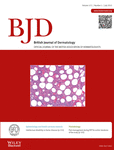

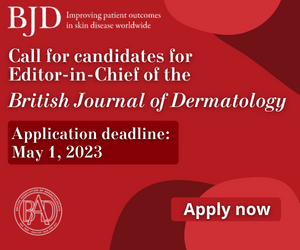
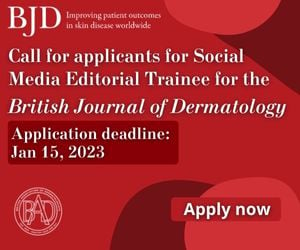

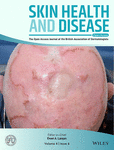
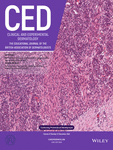
2690-442X.cover.png)